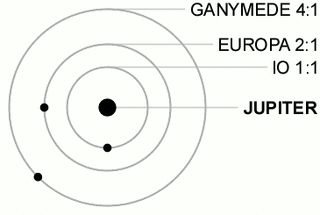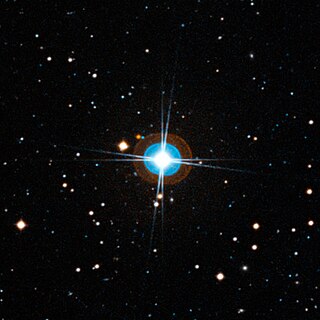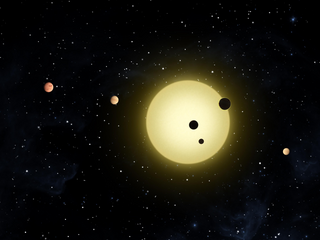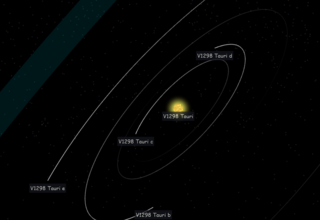
In celestial mechanics, orbital resonance occurs when orbiting bodies exert regular, periodic gravitational influence on each other, usually because their orbital periods are related by a ratio of small integers. Most commonly, this relationship is found between a pair of objects. The physical principle behind orbital resonance is similar in concept to pushing a child on a swing, whereby the orbit and the swing both have a natural frequency, and the body doing the "pushing" will act in periodic repetition to have a cumulative effect on the motion. Orbital resonances greatly enhance the mutual gravitational influence of the bodies. In most cases, this results in an unstable interaction, in which the bodies exchange momentum and shift orbits until the resonance no longer exists. Under some circumstances, a resonant system can be self-correcting and thus stable. Examples are the 1:2:4 resonance of Jupiter's moons Ganymede, Europa and Io, and the 2:3 resonance between Neptune and Pluto. Unstable resonances with Saturn's inner moons give rise to gaps in the rings of Saturn. The special case of 1:1 resonance between bodies with similar orbital radii causes large planetary system bodies to eject most other bodies sharing their orbits; this is part of the much more extensive process of clearing the neighbourhood, an effect that is used in the current definition of a planet.

55 Cancri is a binary star system located 41 light-years away from the Sun in the zodiac constellation of Cancer. It has the Bayer designation Rho1 Cancri (ρ1 Cancri); 55 Cancri is the Flamsteed designation. The system consists of a K-type star and a smaller red dwarf.

Hot Jupiters are a class of gas giant exoplanets that are inferred to be physically similar to Jupiter but that have very short orbital periods. The close proximity to their stars and high surface-atmosphere temperatures resulted in their informal name "hot Jupiters".

HD 219134 is a main-sequence star in the constellation of Cassiopeia. It is smaller and less luminous than the Sun, with a spectral class of K3V, which makes it an orange-hued star. HD 219134 is relatively close to our system, with an estimated distance of 21.34 light years. This star is close to the limit of apparent magnitude that can still be seen by the unaided eye. The limit is considered to be magnitude 6 for most observers. This star has a magnitude 9.4 optical companion at an angular separation of 106.6 arcseconds.
HD 73526 is a star in the southern constellation of Vela. With an apparent visual magnitude of +8.99, it is much too faint to be viewed with the naked eye. The star is located at a distance of approximately 316 light-years from the Sun based on parallax, and is drifting further away with a radial velocity of +26 km/s. It is a member of the thin disk population.

A Super-Earth or super-terran or super-tellurian is a type of exoplanet with a mass higher than Earth, but substantially below those of the Solar System's ice giants, Uranus and Neptune, which are 14.5 and 17.1 times Earth's, respectively. The term "super-Earth" refers only to the mass of the planet, and so does not imply anything about the surface conditions or habitability. The alternative term "gas dwarfs" may be more accurate for those at the higher end of the mass scale, although "mini-Neptunes" is a more common term.
This page describes exoplanet orbital and physical parameters.

HD 10180, also designated 2MASS J01375356-6030414, is a Sun-like star in the southern constellation Hydrus that is notable for its large planetary system. Since its discovery, at least six exoplanets have been observed orbiting it, and some studies have proposed up to nine potential planets, which would make it potentially the largest of all known planetary systems, including the Solar System.

An exoplanet is a planet located outside the Solar System. The first evidence of an exoplanet was noted as early as 1917, but was not recognized as such until 2016; no planet discovery has yet come from that evidence. What turned out to be the first detection of an exoplanet was published among a list of possible candidates in 1988, though not confirmed until 2003. The first confirmed detection came in 1992, with the discovery of terrestrial-mass planets orbiting the pulsar PSR B1257+12. The first confirmation of an exoplanet orbiting a main-sequence star was made in 1995, when a giant planet was found in a four-day orbit around the nearby star 51 Pegasi. Some exoplanets have been imaged directly by telescopes, but the vast majority have been detected through indirect methods, such as the transit method and the radial-velocity method. As of 24 July 2024, there are 7,026 confirmed exoplanets in 4,949 planetary systems, with 1007 systems having more than one planet. This is a list of the most notable discoveries.

Kepler-11, also designated as 2MASS J19482762+4154328, is a Sun-like star slightly larger than the Sun in the constellation Cygnus, located some 2,110 light years from Earth. It is located within the field of vision of the Kepler space telescope, the satellite that NASA's Kepler Mission uses to detect planets that may be transiting their stars. Announced on February 2, 2011, the star system is among the most compact and flattest systems yet discovered. It is the first discovered case of a star system with six transiting planets. All discovered planets are larger than Earth, with the larger ones being about Neptune's size.

A Mini-Neptune is a planet less massive than Neptune but resembling Neptune in that it has a thick hydrogen-helium atmosphere, probably with deep layers of ice, rock or liquid oceans.

Kepler-90, also designated 2MASS J18574403+4918185, is a F-type star located about 2,790 light-years (855 pc) from Earth in the constellation of Draco. It is notable for possessing a planetary system that has the same number of observed planets as the Solar System.

K2-33b is a very young super-Neptune exoplanet, orbiting the pre-main-sequence star K2-33. It was discovered by NASA's Kepler space telescope on its "Second Light" mission. It is located about 453 light-years away from Earth in the constellation of Scorpius. The exoplanet was found by using the transit method, in which the dimming effect that a planet causes as it crosses in front of its star is measured.

K2-138, also designated EPIC 245950175 or EE-1, is a large early K-type main sequence star with a system of at least 6 planets discovered by citizen scientists. Four were found in the first two days of the Exoplanet Explorers project on Zooniverse in early April 2017, while two more were revealed in further analysis. The system is about 660 light-years away in the constellation Aquarius, within K2 Campaign 12.
The term sub-Neptune can refer to a planet with a smaller radius than Neptune even though it may have a larger mass or to a planet with a smaller mass than Neptune even though it may have a larger radius like a super-puff and both meanings can even be used in the same publication.

V1298 Tauri is a young weakly-lined T Tauri star that is part of the Taurus-Auriga association in the Taurus Molecular Cloud. Alternatively it is part of a proposed moving group, called Group 29 that is slightly older. The system has four transiting exoplanets, discovered with the Kepler space telescope in the K2 mission. One of the planets was discovered in August 2019 and the other three were discovered in November 2019 by the same team.
K2-24 is a metal-rich G3-type main sequence star larger and more massive than the Sun, located 560 light-years away in the constellation Scorpius. Two confirmed transiting exoplanets are known to orbit this star. An attempt to detect stellar companions using adaptive optics imaging at the Keck telescope was negative however later observations using lucky imaging at the Danish 1.54 m telescope at La Silla Observatory detected a possible companion at 3.8 arcseconds distance from K2-24. This candidate companion being over 8 magnitudes fainter than K2-24 and with a color temperature of 5400 Kelvin, is inconsistent with a bound main sequence companion.
HD 63433 c is a mini-Neptune exoplanet orbiting the Sun-like star HD 63433. It is the outermost planet in its planetary system, being located 0.1448 astronomical units (21,660,000 km) from its star, and completing one orbit every 21 days. Despite being the outermost planet in the system, it is still located close to its star, meaning that its temperature is hot, being estimated between 267 and 406 °C. HD 63433 c is about 2.7 times larger than Earth and 15.5 times more massive, but still smaller and less massive than Neptune. In 2022, a study showed that its atmosphere, made up of hydrogen, is being evaporated by the strong radiation from its star, causing it to slowly turn into a super-Earth planet.















